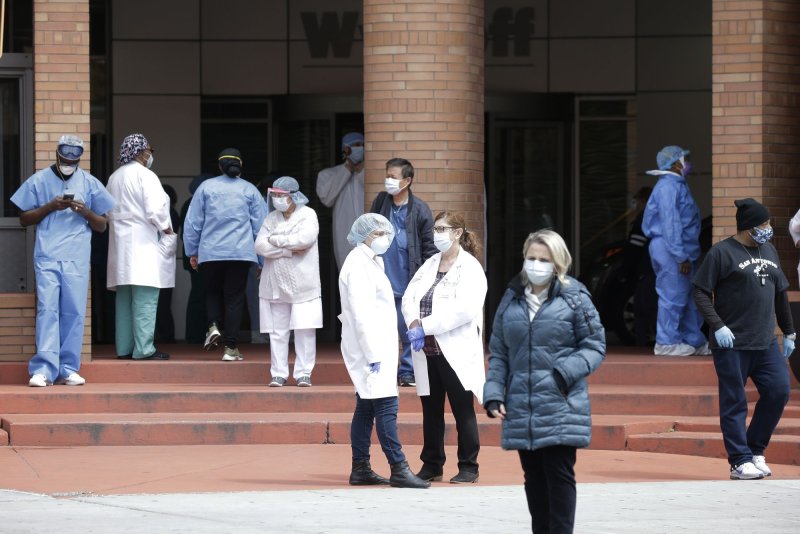Healthcare workers wearing protective face masks and medical clothing stand outside an entrance to Wyckoff Heights Medical Center in New York City in April. Photo by John Angelillo/UPI |
License Photo
May 21 (UPI) -- Front-line healthcare workers are at significant risk for COVID-19 and can contribute to community spread, according to several new studies, including two published Thursday in JAMA Network Open.
The findings -- nearly 47 percent of cases analyzed in six countries were linked to work places, most in healthcare -- suggest front-line workers need better protection, experts say.
"Protecting the high-risk workers ... not only helps protect them from being affected, but it provides an opportunity to prevent secondary infections of family, colleagues and others," Fan-Yun Lan, a doctoral candidate in Population Health Sciences in the Department of Environmental Health at Harvard T.H. Chan School of Public Health, said in a press release.
Lan was among the authors of a study published earlier this week by the journal PLOS ONE, which identified 103 possible cases of workplace COVID-19 transmission out of 690 local transmissions in Hong Kong, Japan, Singapore, Taiwan, Thailand and Vietnam over a 40-day period.
In all, the authors estimated that possible work-related transmission accounted for 47 percent of the initial outbreaks examined in the study. Healthcare workers accounted for 22 percent of the cases among occupational groups, while transportation and sales or service workers were 18 percent each.
Based on the findings, researchers concluded that workplace transmission of SARS-CoV-2 "likely played a substantial role" in the local spread of the disease during the early stages of the outbreak in the six countries included in the study.
"Our study highlights several occupations that have higher potential risks and should be closely monitored as various countries, states and areas begin to gradually reopen their economies," said co-author Stefanos Kales, a professor of environmental health at Harvard T.H. Chan School of Public Health.
A JAMA Network Open study in China, published Thursday, researchers tested 9,684 healthcare workers at Tongji Hospital in Wuhan for COVID-19 between Jan. 1 and Feb. 9. In all, 110, or 1.1 percent, tested positive for the virus, more than 70 percent of them women.
Of the clinicians who became infected, 17, or roughly 16 percent, worked in fever clinics or wards, the authors reported. They also observed that "non-first-line" nurses -- those who cared for patients who didn't have COVID-19 -- younger than 45 years of age were 16 times more likely to be infected than first-line physicians 45 years of age or older.
The authors attribute this to possible inappropriate use of, or inadequate access to, personal protective equipment, or PPE, among these non-first-line staff.
Overall, 93 of the 110 healthcare workers with COVID-19 had mild or moderate cases, with the most common symptoms being fever, fatigue, cough and sore throat, all of which were reported in more than half of those infected. The affected staff tended to be young, with a median age of 37 years old.
Another study published Thursday in JAMA Network Open focused on two hospitals in the Netherlands -- a 700-bed facility in Breda and an 800-bed center in Tiburg. The two medical centers collectively employ more than 9,700 healthcare workers.
Among the staff at the two hospitals, 1,353, or 14 percent, reported fever or respiratory symptoms and were tested for COVID-19, according to the authors. Of these, 86 came back positive for the virus, they added.
Most of the affected healthcare workers in this study also experienced mild disease, the authors said, and only 46, or 53 percent, reported fever. Only three reported having knowingly been exposed to a patient with a COVID-19 diagnosis before the onset of symptoms.
The virus isn't the only health risk front-line clinicians face in treating infected patients. Another study published earlier this week by PLOS ONE found that medical personnel treating coronavirus cases in China were 50 percent more likely to experience symptoms of anxiety, depression and obsessive-compulsive disorder, among other mental health conditions, than the general population.
"The overall mental health status of medical personnel responding to new coronavirus pneumonia is generally higher than that of the norm group in China," the authors wrote.
Policymakers and healthcare organization leaders should implement "measures to alleviate the psychological pressures on medical personnel dealing with the new coronavirus epidemic in China," they said.















